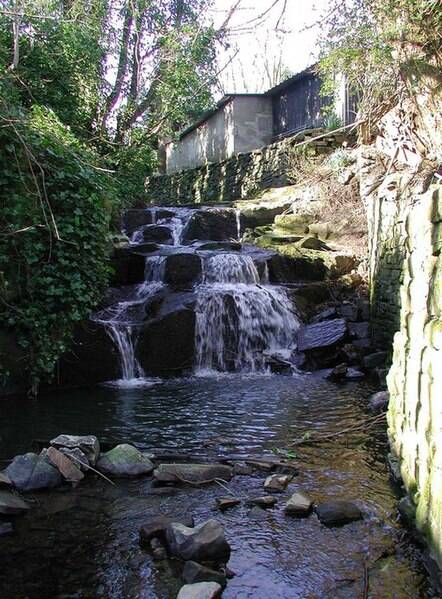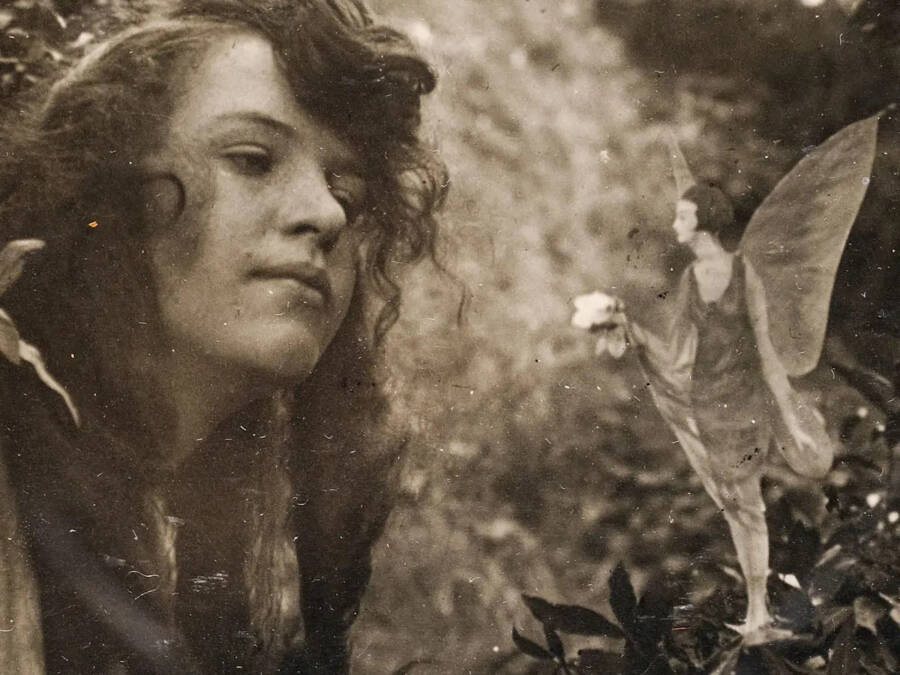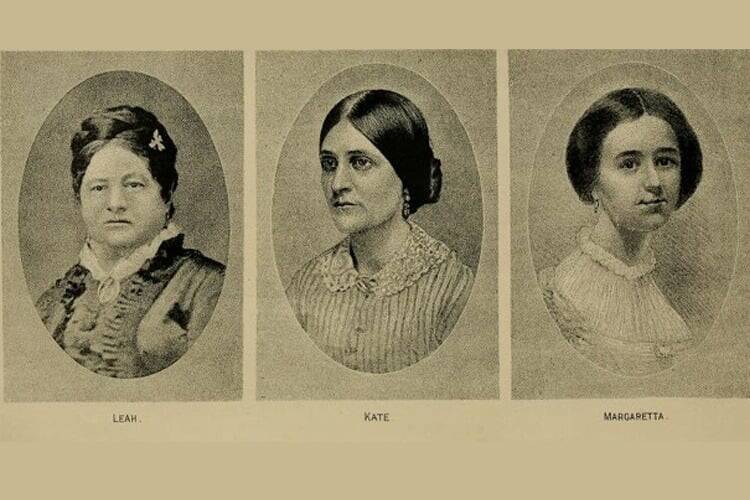Captured by two young girls in the early 20th century, the photos of the Cottingley Fairies appeared to show the girls posing in a garden with tiny, winged sprites.

Public DomainNine-year-old Frances Griffiths posing with the Cottingley Fairies.
In the wake of violent conflicts like the U.S. Civil War and World War I, people of the late 19th and early 20th centuries were searching for miracles. The loss of life both in Europe and in the United States inspired people to ask questions about life after death, spirituality, and the mystical — culminating in the spiritualist movement.
During this period, when people were generally more willing to believe the inexplainable, there emerged a number of infamous fake photos and tales of supernatural occurrences which captured the world’s attention. And the Cottingley Fairies hoax was one such case.
Beginning in 1917, two young girls snapped a series of photos of what appeared to be fairies in their garden in the English countryside. This photo hoax would go on to fool photography experts, leading members of the spiritualist movement, and even Sir Arthur Conan Doyle, the creator of Sherlock Holmes.
This is the story of the Cottingley Fairies and the modern spiritualist movement that rocketed them to infamy.
The Cottingley Fairies Prank
In the summer of 1917, nine-year-old Frances Griffiths and her mother journeyed to Cottingley, England, where they would move in with the family of Frances’ 16-year-old cousin, Elsie Wright.
The Wrights lived in a picturesque wooded area near a garden stream called Cottingley Beck. Frances and Elsie quickly became close, and often ventured down to the stream to play.
One day, the girls came back from the stream covered in mud. When their parents scolded them for the mess, the girls protested that they had just been “to see the fairies,” according to BBC News.

Paul Glazzard/Wikimedia CommonsThe spot where Elsie Wright and Frances Griffiths claimed to have seen the fairies.
As proof, they took a camera down to the stream — and captured the first in a series of photographs now known as the “Cottingley Fairies.”
The Photos Spread Throughout England
When Elsie’s father, Arthur Wright, developed the film, he found a photo that appeared to show little Frances posing in the garden with four winged sprites. Arthur immediately suspected that the girls had fabricated the photograph. So, the girls decided to capture even more evidence, snapping a photo of Elsie posing with a fairy.
Elsie’s mother, Polly, did not share her husband’s skepticism. She had become interested in the spiritualist movement, a social-religious movement of the late 19th century and early 20th century, and wanted to show the pictures to local spiritualist groups.
In 1919, she brought the photos to a meeting of the Theosophical Society in the nearby town of Bradford. The society’s leading member, Edward Gardner, viewed the images with wonder.
To Gardner, the Cottingley Fairies offered proof of the group’s main belief: that great metaphysical changes were occurring, and that humankind was transforming into its most perfect form as time progressed. He began to use the photos in his lectures on spiritualism, presenting them as “evidence” of the supernatural.
Gardner also took the photos to photography expert Harold Snelling for authentication. According to Paul Smith’s essay in The Good People: New Fairylore Essays, Snelling declared them to be “entirely genuine,” saying, “these are straight forward photographs of whatever was in front of the camera at the time.”

Public DomainElsie Wright with the “Cottingley Fairies.”
Before long, the images spread like wildfire throughout England. By 1920, they had caught the attention of Sir Arthur Conan Doyle, a noted spiritualist and the author of The Adventures of Sherlock Holmes.
Sir Arthur Conan Doyle’s “Fairies Photographed”
Sir Arthur Conan Doyle was writing a story about fairies for The Strand magazine when he first heard of the Cottingley Fairies. Entranced, he asked the Wrights for permission to use the images in his piece.
Conan Doyle was originally skeptical of the photos’ authenticity. But according to Dr. Merrick Burrow, Head of English and Creative Writing at the University of Huddersfield, he believed that, if proven genuine, they could change the world.
“If these photos proved the existence of fairies, and that you could photograph the supernatural, then they were a staging post in the argument for spiritualism,” Burrow explained.
After consulting multiple experts, Conan Doyle apparently came to the conclusion that the photos were genuine. In his article, published in December 1920, he wrote that “after carefully going into every possible source of error, a strong prima facie case has been built up” for their authenticity.
“The recognition of their existence will jolt the material twentieth-century mind out of its heavy ruts in the mud, and will make it admit that there is a glamour and a mystery to life. Having discovered this, the world will not find it so difficult to accept that spiritual message supported by physical facts which has already been so convincingly put before it.”
Conan Doyle’s article was a hit, gaining popularity in both the United States and Australia. As the photos exploded into an international sensation, Elsie Wright and Frances Griffiths were given cameras of their own and asked to take even more photos in 1921. They obliged, rounding out the series with a total of five photos.
What had begun as a family prank was now one of history’s most legendary photo hoaxes.

Public DomainElsie Wright playing with a winged gnome.
The Rise Of Spiritualism Across Western Europe And The United States
The story of how the Cottingley Fairies photographs came to be can be partially explained by the rise of the modern spiritualism movement.
The movement was born in the 1840s during the Second Great Awakening, a Protestant religious revival in the United States. It was largely driven by the belief that life continued after death and that the living could make contact with spirits.
Famous pioneers of spiritualism included Emanuel Swedenborg, Andrew Jackson Davis, and the Fox sisters in New York: Leah, Kate, and Maggie. The sisters toured the country in the 19th century, holding seances where participants heard knocks and other noises supposedly made by spirits. This appeal to the senses captured the attention of the American public.
Eventually, entire towns for spiritualism formed, including Lily Dale, a New York hamlet founded in 1879 that stands as the largest center of the spiritualist movement today.

Wikimedia CommonsThe Fox sisters played a major role in popularizing spiritualism.
A large part of the reason spiritualism took off in the late 19th century and early 20th century was a pervasive feeling of loss. Following the devastating casualties of both the U.S. Civil War and World War I, families were desperate for connection to their lost loved ones.
This desire inspired photographers to develop “spirit photography” — photographs produced using techniques like double exposure to create the illusion of a ghost in the background.
It is from this cultural phenomenon that the Cottingley Fairies were born and found their success in the public eye.
The Legacy Of The Cottingley Fairies
Over the decades, people started to recognize the Cottingley Fairies story for what it truly was: a hoax. However, it wasn’t until 1983 that Frances Griffiths admitted she and her cousin Elsie Wright had staged the images using paper cutouts and hatpins
“I never even thought of it being a fraud,” Griffiths told the BBC at the time. “It was just Elsie and I having a bit of fun.”
She explained that the girls had hand-copied images from Princess Mary’s Gift Book, a children’s book published in 1914. Then, they added wings to their cutout figures and used hair pins to hold the “fairies” upright as they snapped the photos.
But even if their prank had gotten out of hand, Griffiths said she didn’t have any regrets about creating the Cottingley Fairies.
“People often say to me ‘Don’t you feel ashamed that you have made all these poor people look like fools? They believed in you,'” she said. “But I do not, because they wanted to believe.”
After reading about the Cottingley Fairies, peruse this gallery of bizarre photos from some of the weirdest moments in history. Then, read about the spaghetti tree hoax that fooled hundreds of people.





